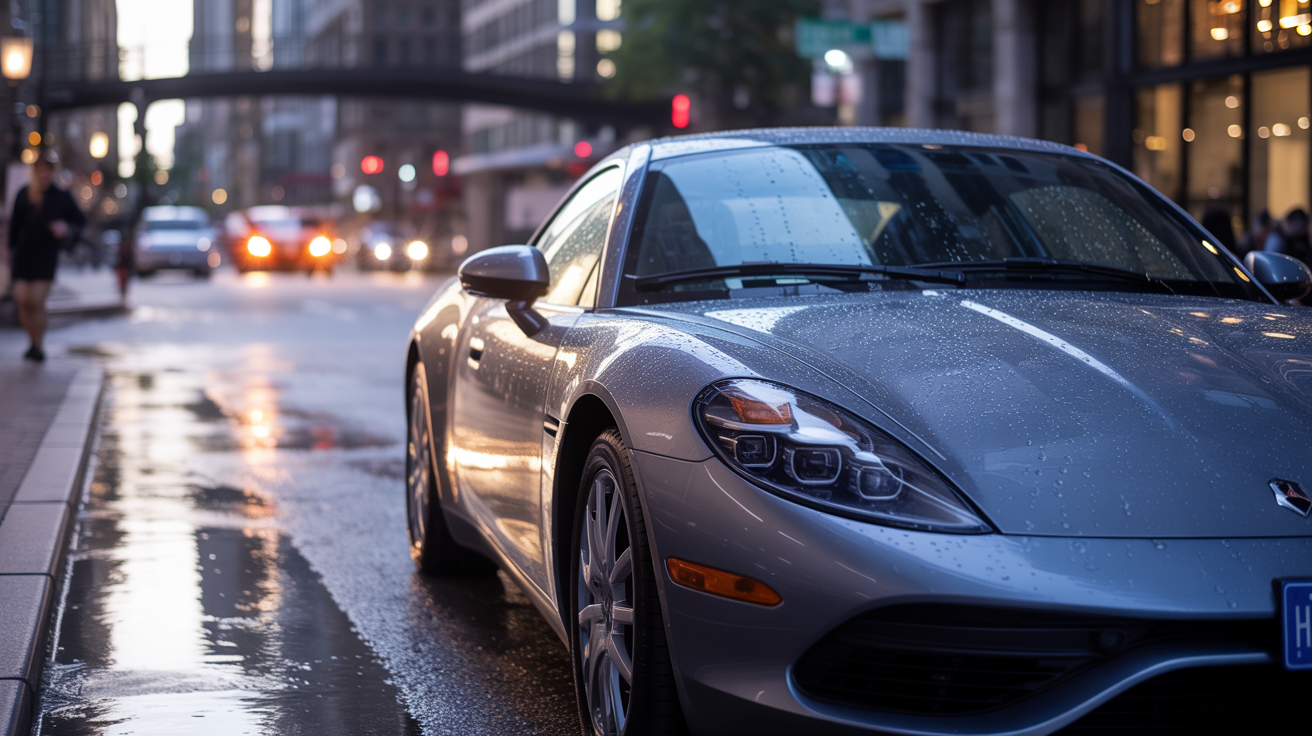7 Warning Signs Your Car's Paint Needs Protective Coating (Toronto Driver's Guide)

Your car's paint isn't just about looks—it's your first line of defense against Toronto's harsh elements. But when that protection starts failing, your vehicle shows clear warning signs that most drivers miss until it's too late.
After working with numerous vehicles across the GTA, we've noticed the same patterns emerge. Cars that could have been saved with early intervention end up needing costly paint correction or even full repaints. The good news? Your car gives you plenty of warning before permanent damage sets in.
Water Doesn't Behave Like It Used To
Here's the easiest test you can do right now: spray water on your car's hood after washing. Healthy paint makes water form tight beads that roll off easily. If water spreads flat across the surface or clings in sheets, your clear coat is losing its protective properties.
This change happens gradually in Toronto's variable climate. Rain, humidity, and temperature swings break down the hydrophobic layer that keeps contaminants from bonding to your paint. When water stops beading, dirt and pollutants start sticking—and that's when real damage begins.
Pro tip: Test different areas of your car. The hood and roof usually show water behavior changes first since they get the most UV exposure.
When we work with clients at Precision Performance Films, we help vehicle owners recognize these early warning signs before they become expensive problems. Our Toronto PPF applications restore that crucial barrier your paint needs.
Your Paint Surface Feels Different
Run your hand across your car's paint after washing. A healthy finish should feel glass-smooth. If you notice roughness, grittiness, or a sticky texture, embedded contaminants have penetrated your clear coat.
This roughness comes from:
- Road debris that's worked its way into microscopic paint pores
- Industrial fallout from Toronto's urban environment
- Biological contaminants like tree sap and insect residue
The sticky feeling often indicates that acids from bird droppings or tree sap have started etching your clear coat. These contaminants contain enzymes like amylase that literally digest your paint's protective layer through a process called hydrolytic cleavage.
Quick check: If your paint feels rough even after a thorough wash, professional decontamination is needed before the damage becomes permanent.
The Shine Has Lost Its Depth
Remember how your car looked when it was new? That deep, glossy finish reflected light like a mirror. When paint starts failing, it loses that depth and appears flat or chalky—even right after washing.
This dullness signals oxidation, where UV radiation breaks down the polymer chains in your clear coat. In the GTA's intense summer sun, this process accelerates rapidly. Winter road salt makes it worse by attracting moisture that speeds up chemical reactions.
Studies show that combined UV and contaminant exposure can reduce gloss levels significantly within just a few months of unprotected exposure.
Warning sign: If your black or dark-colored car looks gray or faded in direct sunlight, oxidation has already begun.
Dirt Sticks Like Glue
Does your car look dirty just days after washing? When protective coatings fail, dirt and grime bond directly to your paint instead of sitting on top where they can be easily rinsed away.
Here's what we see happening across Vaughan, Markham, and Richmond Hill:
- Water spots that won't budge with normal washing
- Bird droppings that leave permanent marks within hours
- Tree sap that seems to melt into the paint surface
- Road grime that clings despite regular cleaning
This pattern is so common that Precision Performance Films has developed specific assessment protocols for each type of contamination. According to our experts, "If you notice water no longer beads up, dirt clings to the paint, or the surface looks dull, it's time to consider a refresh."
This isn't just an aesthetic issue. When contaminants bond to bare paint, they create microscopic anchoring points that make future cleaning harder and more damaging.
Scratches and Marks Appear Out of Nowhere
Swirl marks, fine scratches, and mysterious etchings that weren't there last week signal that your paint's protective layer has worn thin. Without that buffer, every car wash, every wipe-down, every contact leaves marks.
Bird droppings are particularly destructive in this vulnerable state. Research from Paint & Coatings Industry magazine shows that bird waste combined with UV exposure creates surface etching, reduces gloss, and causes permanent discoloration—especially on red vehicles, which attract 18% more bird activity.
In Toronto's High Park area and other tree-heavy neighborhoods, this becomes a constant threat. The acids in bird droppings can cause visible damage within hours when your clear coat is compromised.
Reality check: If you're seeing new scratches after gentle washing, your paint has lost its protective barrier.
Your Car Attracts Stains Like a Magnet
Remember when spilled coffee or bird droppings were wiped away easily? When paint protection fails, these same substances create permanent stains that resist normal cleaning methods.
This happens because contaminants can now penetrate into the paint structure instead of sitting on a protective surface. Tree sap bakes into the clear coat under summer heat. Road salt creates white residue that etches permanent marks. Even water leaves mineral deposits that won't budge.
At Precision Performance Films, we note that professional ceramic coatings "offer unmatched durability, lasting 2 to 5 years, with resistance to scratches, UV damage, and environmental contaminants" by creating a molecular bond that prevents this penetration.
Test this: If cleaning products that used to work no longer remove stains, your paint needs professional protection.
Time for Professional Protection
When multiple warning signs appear, acting fast saves money and preserves your car's value. Professional protective coatings like ceramic coating and paint protection film create a barrier that your failing clear coat can no longer provide.
As our experts explain, "If you're concerned about scratches and rock chips, PPF is the way to go," especially for vehicles facing Toronto's challenging road conditions.
Here's what professional protection offers:
- Enhanced water repellency that makes washing easier
- UV resistance that prevents oxidation and fading
- Chemical resistance against bird droppings, tree sap, and road salt
- Physical barrier that takes damage instead of your paint
Don't wait for permanent damage. Early intervention with professional coating application costs far less than paint correction or refinishing later. The team at Precision Performance Films has seen too many cases where a simple protective coating could have prevented thousands in repair costs.
Ready to Protect Your Investment?
Your car's paint is showing you what it needs. Those changes in water behavior, texture, and appearance aren't just cosmetic—they're warnings that expensive damage is coming.
At Precision Performance Films, we've helped many GTA drivers protect their vehicles before minor issues became major expenses. Using premium XPEL and Suntek products, our certified installers create lasting barriers that keep your car looking showroom-fresh despite Toronto's challenging conditions.
Our expertise with both ceramic coating and paint protection film means we can recommend the exact solution your vehicle needs. Whether you're dealing with early warning signs or want to prevent them entirely, Precision Performance Films has the experience to guide you through the best protection strategy.
Ready to give your paint the protection it deserves? Contact Precision Performance Films today for a professional assessment and learn which solution—ceramic coating or paint protection film—best fits your driving conditions and budget.
Frequently Asked Questions
Q: How can I tell if my car's paint is fading due to UV damage in Toronto? A: Look for uneven color spots, chalky texture, or a flat appearance that lacks depth. Dark colors often appear gray or washed out. If you notice these signs, consult a professional for proper assessment.
Q: What are signs of road salt damage on car paint in the GTA? A: Watch for white residue that won't wash off, bubbling under the paint, or brittleness around edges. Salt attracts moisture and accelerates rust formation. Professional evaluation is recommended if you see these indicators.
Q: How quickly can bird droppings damage car paint in Toronto? A: Bird droppings contain acids and enzymes that can cause permanent etching within hours, especially when combined with UV exposure. Red vehicles are particularly susceptible, attracting 18% more bird activity.
Q: When should I consider paint protection film versus ceramic coating? A: PPF provides superior protection against physical damage like rock chips and scratches, while ceramic coating excels at chemical resistance and ease of maintenance. A professional assessment can determine which suits your driving conditions better.
Q: Can I apply protective coatings myself, or do I need professional installation? A: Professional installation ensures proper surface preparation, contamination removal, and correct application techniques. DIY attempts often fail due to inadequate prep work or application errors, potentially causing more damage than protection.
Get a Quote for Paint Protection Film Today


.svg)

.svg)
.jpg)











